How to Choose the Perfect Sofa for Your Living Room: Style, Size, and Comfort Tips
Table of Contents
The sofa is often the centerpiece of a living room—where we relax, entertain, and unwind after long days. But with countless options on the market, choosing the perfect sofa can quickly become overwhelming. Should you go for a sectional or a classic three-seater? Leather or fabric? Bold color or neutral tones? Each decision plays a key role in how your space looks and functions.
In this guide, we break down everything you need to know to confidently select a sofa that complements your living room’s style, suits your daily needs, and offers long-lasting comfort. From understanding dimensions and configurations to decoding fabric choices and style aesthetics, you’ll find actionable insights that make sofa shopping easier and more enjoyable.
Let’s dive into how to choose the perfect sofa for your living room—a piece that brings both beauty and function to your home.
Measure Your Space First
Before falling in love with a sofa design, ensure it will fit comfortably in your living room. Start by measuring the dimensions of the room and the space you plan to dedicate to the sofa.
Key Points to Measure
- Wall length where the sofa will be placed
- Distance from doorways, walkways, and windows
- Ceiling height if considering tall-backed designs
Visual Breakdown
| Measurement Type | Why It Matters | Tips |
| Width | Ensures sofa fits the wall | Leave 18″ on either side for balance |
| Depth | Affects walking space | Minimum 30″ clearance around the sofa |
| Height | Impacts room openness | Lower backs for small rooms |
Carefully measured dimensions help avoid costly returns and awkward layouts.
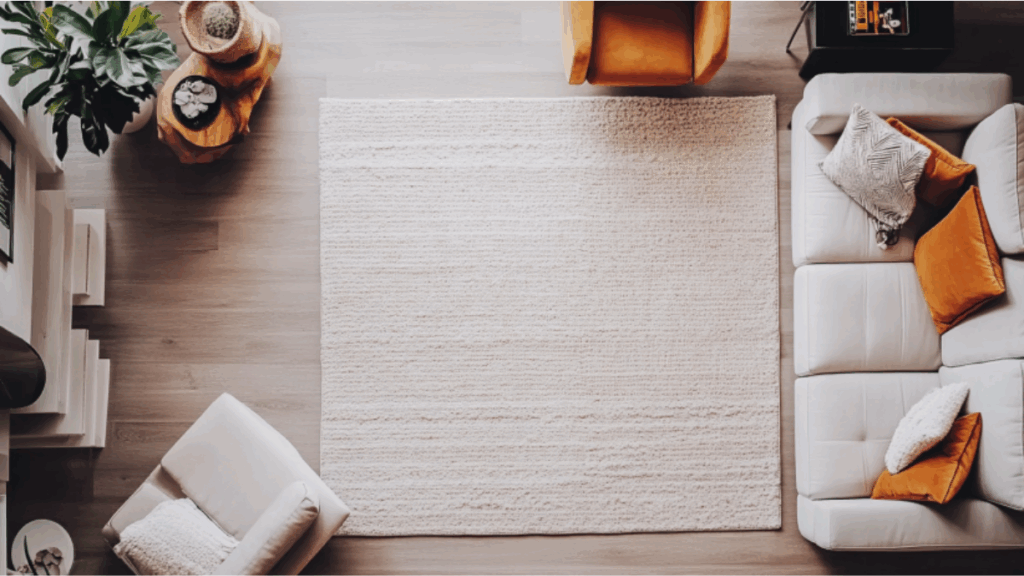
Choose the Right Sofa Style
Your sofa style should complement your room’s aesthetic. Whether you’re aiming for classic elegance or modern minimalism, the right shape and design will pull the entire space together.
Popular Sofa Styles
- Chesterfield: Rolled arms, deep tufting—ideal for traditional decor
- Mid-century modern: Tapered legs, clean lines—great for minimalist vibes
- Lawson: Plush cushions, relaxed style—perfect for casual comfort
Visual Breakdown
| Style | Key Features | Best For |
| Chesterfield | Tufted back, rolled arms | Classic or vintage interiors |
| Mid-century Modern | Slim profile, angled legs | Urban, small-space living |
| Sectional | Modular, L-shape or U-shape | Large families or open floor plans |
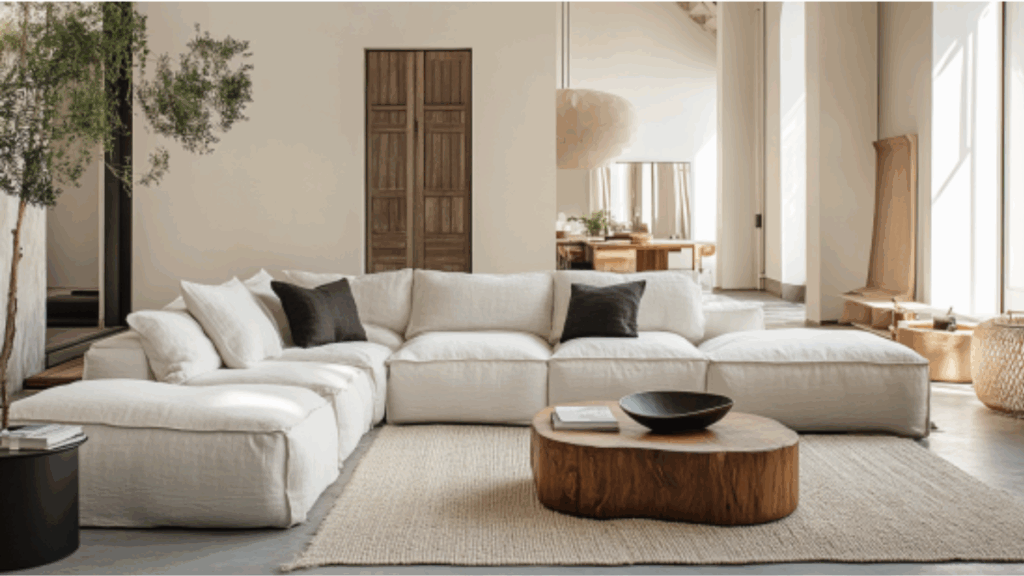
Prioritize Comfort and Cushion Type
Comfort is more than just sitting on a soft cushion. The type of filling and support system in a sofa affects its long-term coziness.
Common Cushion Fillings
- Foam: Firm and supportive, keeps shape well
- Feather/down: Soft, luxurious, but needs fluffing
- Hybrid: Foam core with feather wrap for balance
Visual Breakdown
| Filling Type | Feel | Maintenance | Longevity |
| Foam | Firm and bouncy | Minimal | High |
| Feather | Soft and plush | Frequent fluffing | Medium |
| Hybrid | Balanced comfort | Occasional adjustment | High |
Choose based on how you use your sofa: daily lounging, formal sitting, or movie marathons.

Pick the Best Fabric or Upholstery
Fabric not only defines the sofa’s look but also its durability and maintenance. Consider lifestyle factors like pets, kids, and allergy concerns.
Fabric Options
- Cotton/Linen: Natural and breathable, but stains easily
- Leather: Durable and sleek, but requires conditioning
- Performance Fabric: Stain-resistant, great for families
Visual Breakdown
| Fabric Type | Pros | Cons |
| Cotton/Linen | Comfortable, natural | Wrinkles, stains easily |
| Leather | Long-lasting, stylish | Can crack without care |
| Performance Fabric | Kid- and pet-friendly | Limited texture variety |
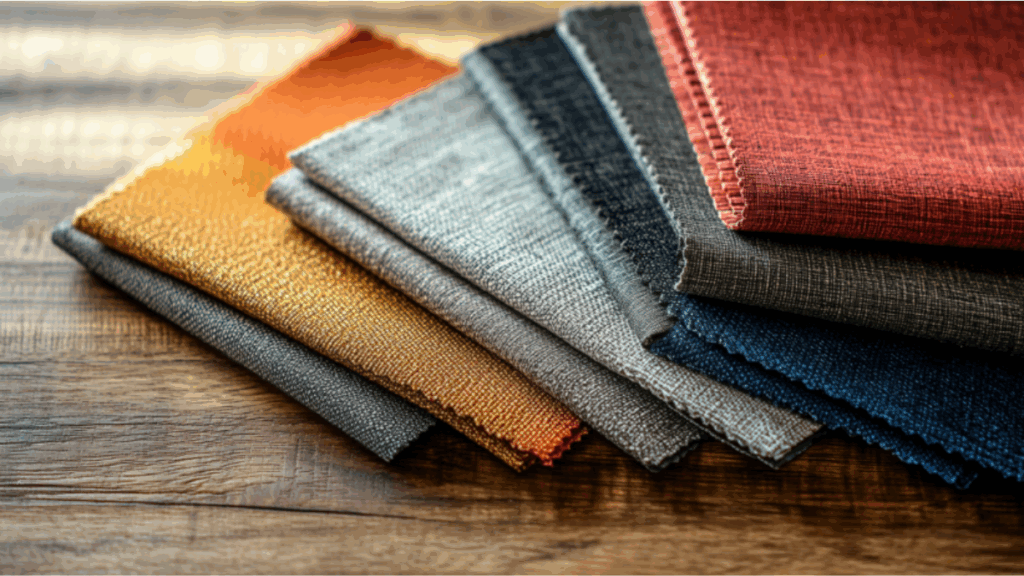
Consider Color and Pattern Choices
Color and pattern influence mood, room brightness, and design versatility. Sofas in neutral tones often last stylistically, while bold patterns can become a statement.
Choosing Based on Room Style
Neutral shades like beige or gray for timeless appeal
- Deep hues for a moody, intimate feel
- Patterned upholstery for eclectic or boho interiors
Visual Breakdown
| Color/Pattern | Design Impact | Pairing Tip |
| Neutrals | Easy to update with pillows/throws | Great with colorful accents |
| Bold Colors | Adds personality and drama | Keep walls and rugs subtle |
| Patterns | Showcases style and uniqueness | Mix with solid decor items |
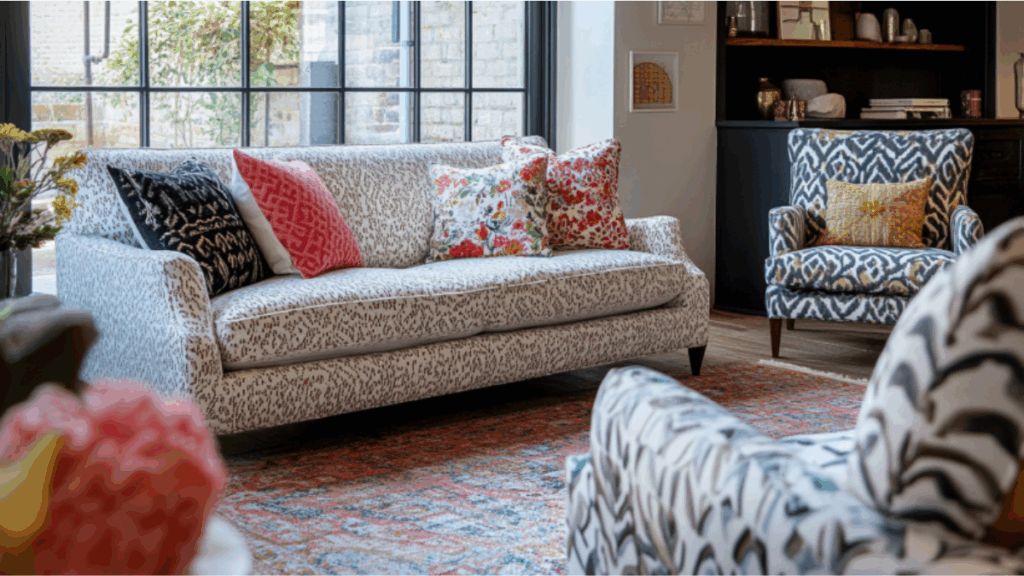
Evaluate Frame Construction and Durability
Beyond appearances, a sturdy sofa frame ensures longevity. This is particularly important for high-traffic homes.
Best Frame Materials
- Kiln-dried hardwood: Resists warping and cracking
- Plywood: Affordable and strong (if multi-layered)
- Particleboard: Less durable, avoid for long-term use
Visual Breakdown
| Material Type | Durability | Cost Range | Ideal Use Case |
| Kiln-dried Hardwood | Very High | $$$ | Premium, long-term sofa |
| Plywood | Moderate-High | $$ | Budget-friendly, reliable |
| Particleboard | Low | $ | Temporary or light use |
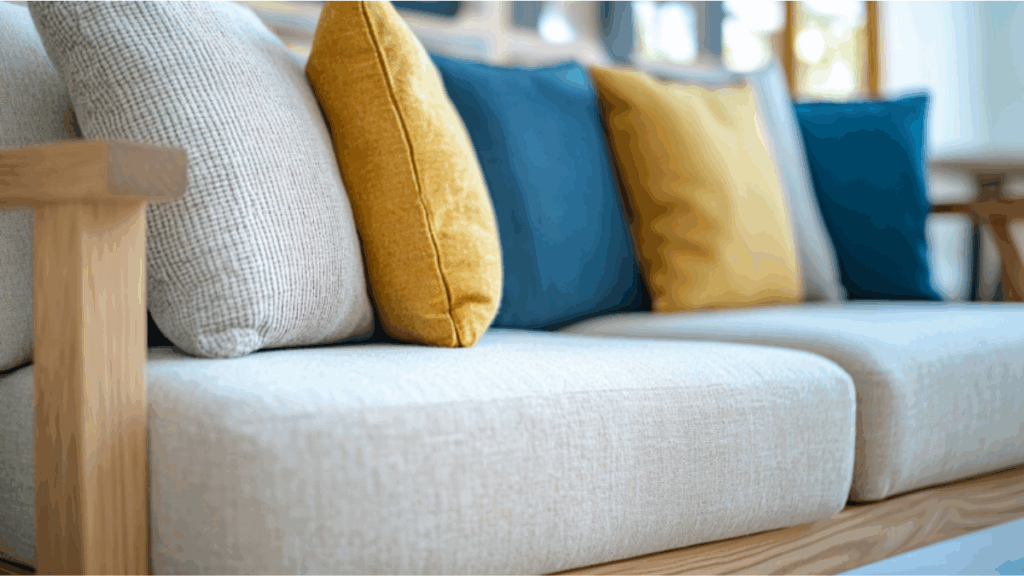
Think About Functionality and Layout
Function should never be overlooked. Do you need a pull-out sleeper, storage, or modular flexibility? Your lifestyle will dictate these choices.
Layout Considerations
- Small spaces benefit from modular or armless sofas
- Large families may need sectionals with chaise lounges
- Multifunctional needs can include sleeper or recliner sofas
Visual Breakdown
| Sofa Feature | Functionality Benefit | Ideal For |
| Sleeper Sofa | Extra bed for guests | Apartment living or guest space |
| Storage Sofa | Hidden compartments for clutter | Small homes |
| Recliner Sectionals | Maximum comfort and adjustability | Movie nights and relaxation |
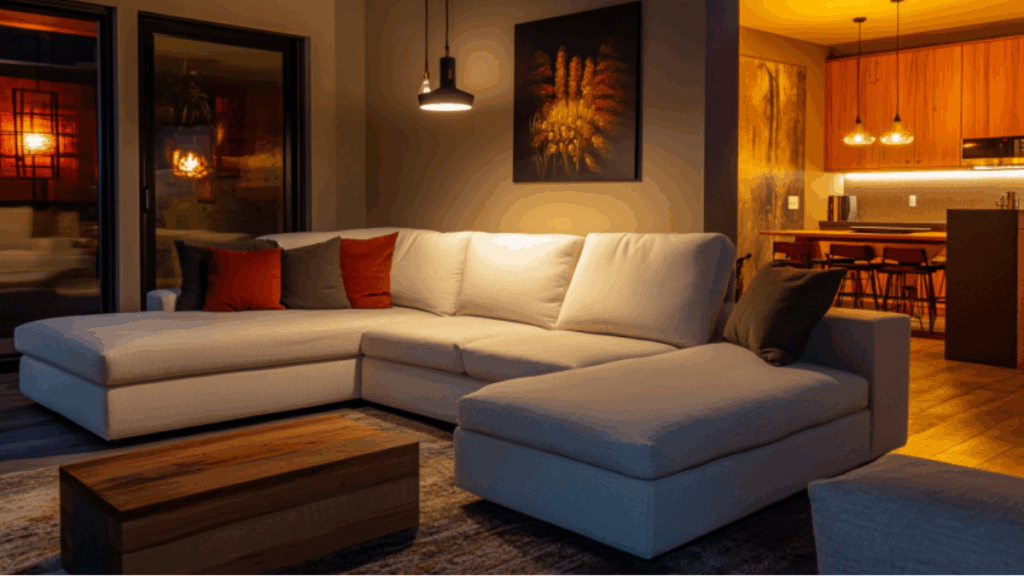
Prioritize Comfort and Cushion Type
Choosing a comfortable sofa means going beyond appearances. While many sofas may feel plush at first touch, the real test is how they perform over time. Foam cushions, for instance, retain their shape well and provide even support, making them ideal for structured seating. They’re particularly well-suited for people with back issues or those who prefer a firmer sit.
On the other hand, down-filled cushions offer a luxurious, sink-in feel that’s perfect for lounging. However, they do require regular fluffing and may lose shape faster. The hybrid option offers a happy medium—a high-resilience foam core wrapped in down or polyester for a mix of structure and softness.
How to Pick Cushion Type Based on Use
| User Type | Best Cushion Type | Reason |
| Back Support Seekers | High-density Foam | Provides firm, ergonomic support |
| Loungers & Relaxers | Down/Feather | Soft, sink-in experience |
| Family Use | Hybrid | Balanced, durable, low-maintenance |
Always sit on the sofa before buying or read reviews carefully when purchasing online.
Consider Color and Pattern Choices
Color is one of the most personal choices in sofa selection. It affects how large or cozy a room feels and can completely transform your interior’s mood. Neutral sofas are especially versatile. A gray or beige couch acts as a blank canvas that evolves with seasonal pillows or throws. Bold-colored sofas—like emerald green or navy blue—can command attention and define your room’s personality.
Patterned upholstery adds an element of fun or sophistication. Stripes can elongate a small space visually, while floral prints bring a soft romantic feel. However, patterns may date faster than solids, so use them when you’re confident in your long-term style preferences.
Color & Mood Connection
| Color Type | Mood Created | Works Best In… |
| Neutrals | Calm, adaptable | Any style, small or large rooms |
| Bold Colors | Energized, expressive | Accent-focused or boho designs |
| Patterns | Playful or artistic | Eclectic or creative spaces |
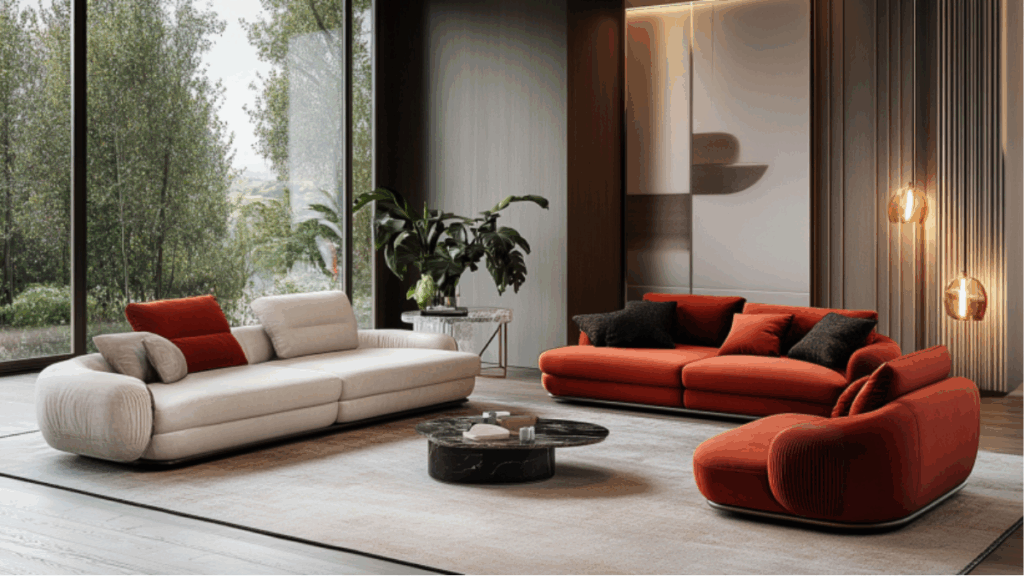
Conclusion
Choosing the perfect sofa is a balance of style, function, and comfort. With so many factors to consider—from fabric type and frame durability to layout needs and color schemes—this purchase becomes a key design decision in any living room. By focusing on your lifestyle, room layout, and personal taste, you can invest in a piece that not only enhances your space but brings lasting comfort and joy.
Whether you’re furnishing a brand-new home or upgrading an outdated couch, use these detailed tips to find a sofa that fits seamlessly into your lifestyle and transforms your living room into a stylish, welcoming retreat.

